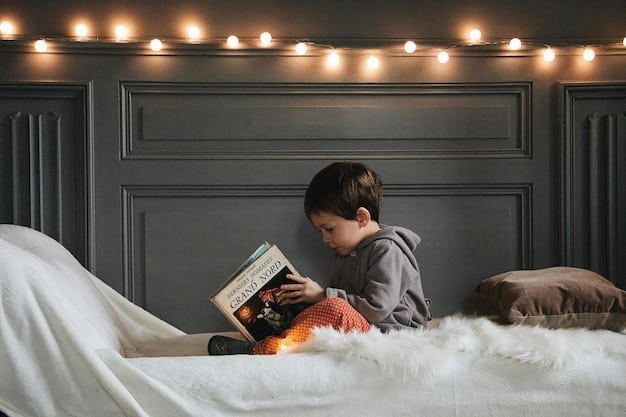Practical Solutions: Creating a Sleep-Conducive Environment for Your Child

Creating a sleep-conducive environment for your child involves practical solutions, such as optimizing room temperature, minimizing noise and light, establishing calming routines, and selecting comfortable bedding to promote restful sleep.
Ensuring your child gets enough sleep is essential for their growth, development, and overall well-being. Let’s explore some practical solutions: how to create a sleep-conducive environment for your child, turning bedtime battles into peaceful slumbers.
Understanding the Importance of Sleep for Children
Sleep is not just downtime; it’s a crucial period for children’s physical and mental restoration. Adequate sleep supports healthy brain development, boosts the immune system, and improves mood and behavior. Creating an environment that promotes sleep is an investment in your child’s overall well-being.
The Impact of Sleep Deficiency
Sleep deprivation can manifest in various ways, affecting a child’s cognitive function, emotional regulation, and physical health. Recognizing the signs of sleep deficiency is the first step in addressing the issue and creating a more sleep-friendly environment.
- Irritability and mood swings.
- Difficulty concentrating and focusing at school.
- Increased susceptibility to illnesses.
- Hyperactivity and impulsivity.
Parents often think hyperactivity is due to other reasons such as the child’s behavior or even food allergies, but it is more likely that sleep deprivation is the reason for hyperactivity.
Benefits of a Good Night’s Sleep
Conversely, a child who consistently gets enough sleep reaps numerous benefits. These range from improved academic performance to enhanced athletic abilities and a stronger sense of self-esteem. A well-rested child is a happier, healthier child.
Prioritizing children´s sleep is not only essential for their health but also for their well-being. The benefits of giving children a good night´s sleep are plenty.
A solid night’s sleep gives your child a boost in their performance in school, especially when they have tests around the corner.

Optimizing the Bedroom Environment
The physical environment of your child’s bedroom plays a significant role in their ability to fall asleep and stay asleep. Optimizing factors like temperature, lighting, and noise levels can transform a child’s room into a sleep sanctuary. By taking care of the details, you are increasing the changes of the child sleeping peacefully.
Temperature Control
Maintaining a cool, comfortable temperature in the bedroom is crucial for promoting sleep. A room that is too hot or too cold can disrupt sleep patterns and make it difficult for a child to fall asleep.
The recommended temperature for a sleep environment is between 65 and 70 degrees Fahrenheit (18 to 21 degrees Celsius). This temperature range is condusive to sleep.
Light Management
Exposure to light, especially blue light emitted from electronic devices, can interfere with the body’s natural sleep-wake cycle. Minimizing light exposure in the evening and creating a dark sleep environment can signal to the body that it’s time to rest.
Make sure to incorporate dark shades on the windows to stop any outside light from coming inside. This is important even if there is no street light around your home, since moonlight can also disturb your child’s sleep.
Noise Reduction
A quiet sleep environment is essential for minimizing distractions and promoting relaxation. While complete silence may not be achievable, reducing noise levels can help create a more conducive atmosphere for sleep.
Taking care of children´s light and shade environment can be complicated by the neighborhood you live in. If your family lives in a busy area, the nights can be quite noizy. In this case, sound reduction features such as thicker windows can be a great option.
These are just some of the options your could go for when trying to have a quieter sleep environment for your loved ones.
Optimizing the bedroom environment involves addressing temperature, lighting, and noise levels to create a sleep-conducive space.
Establishing a Bedtime Routine
Consistency is key when it comes to establishing a bedtime routine for children. A predictable routine signals to the body that it’s time to wind down and prepare for sleep. This, in turn, makes the process of sleeping easier and faster.
The Power of Predictability
A consistent bedtime routine helps regulate the body’s internal clock and promotes a sense of security for children. Knowing what to expect each night can reduce anxiety and resistance to bedtime.
Sample Bedtime Routine
A well-structured bedtime routine might include activities such as a warm bath, reading a book, and gentle stretching. The specifics of the routine can be tailored to the individual child’s preferences and needs.
- Warm bath: This can help relax muscles and lower body temperature.
- Reading a book: Choose a calming story to read together.
- Gentle stretching: Simple stretches can release tension and promote relaxation.
- Quiet conversation: A few moments of calm conversation fosters connection and relaxation.
Limiting Screen Time
The blue light emitted from screens can suppress the production of melatonin, a hormone that regulates sleep. It’s essential to limit screen time in the hours leading up to bedtime to promote optimal sleep.

Choosing Comfortable Bedding
The choice of bedding can significantly impact a child’s comfort and ability to fall asleep. Selecting soft, breathable materials and ensuring proper support can enhance the sleep experience. The sense of comfort is everything for children to calm down and fall asleep. No one likes being uncomfy when trying to rest.
Material Matters
Opt for natural, breathable materials like cotton or bamboo for bedding. These materials help regulate body temperature and wick away moisture, keeping your child comfortable throughout the night.
Pillow Talk
Choose a pillow that provides adequate support for your child’s head and neck. The right pillow can help maintain proper spinal alignment and prevent discomfort during sleep.
Make sure to analyze all the dimensions of the pillows to ensure those dimensions fit your child. Choosing the right type of pillow can be a challenging task for first-time parent, who do not know the dimensions of kids pillows.
Mattress Selection
A supportive mattress is essential for a good night’s sleep. Consider factors like firmness, material, and size when selecting a mattress for your child. The mattress can be a reason for the child not sleeping as well.
A comfortable bedding promotes a sense of comfort and security, contributing to better sleep quality.
Addressing Sleep Challenges
Despite your best efforts, sleep challenges may still arise. Understanding common sleep problems and developing strategies to address them can help you navigate these hurdles and promote better sleep for your child.
Nightmares and Night Terrors
Nightmares and night terrors can disrupt sleep and cause distress for both children and parents. Providing reassurance and creating a safe, supportive environment can help minimize these occurrences.
Sleepwalking and Sleeptalking
Sleepwalking and sleeptalking are relatively common sleep behaviors that can sometimes be alarming. In most cases, these behaviors are harmless and resolve on their own.
- Ensure the environment is safe.
- Avoid waking the child.
- Gently guide the child back to bed.
Seeking Professional Help
If sleep problems persist or are causing significant distress, it may be necessary to seek professional help. A pediatrician or sleep specialist can provide guidance and support in addressing underlying sleep issues.
The Importance of Parental Involvement
Parents play a vital role in creating a sleep-conducive environment for their children. Leading by example and actively participating in bedtime routines can foster healthy sleep habits that last a lifetime. Parental involvement is also a great boost to the kids self-esteem.
Modeling Healthy Sleep Habits
Children often emulate their parents’ behaviors, so it’s essential to model healthy sleep habits. Prioritize your own sleep and demonstrate the importance of rest and relaxation.
Creating a Supportive Environment
Your attitude towards children’s sleep must be the most supportive possible, so they feel save and comfortable. This is especially true when helping children with their own sleep patterns, teaching from your good habits. When it comes to establishing routines, you need to stick to the plan.
- Be patient and understanding.
- Offer encouragement and praise.
- Create a positive association with bedtime.
Consistency is Key
Consistency is paramount when establishing healthy sleep habits. Stick to the bedtime routine, even on weekends and holidays, to reinforce positive associations with sleep.
Active parental involvement and modeling healthy sleep habits are crucial for creating a sleep-conducive environment.
| Key Point | Brief Description |
|---|---|
| 🛌 Optimized Environment | A room with ideal temperature, dark, and quiet promotes better sleep. |
| ⏰ Consistent Routine | A regular bedtime routine signals to the body it’s time to sleep. |
| 🧸 Comfortable Bedding | Soft, breathable bedding enhances comfort and sleep quality. |
| 👪 Parental Involvement | Parents modeling good habits support healthy sleep routines for kids. |
FAQ
▼
A sleep-conducive environment is a room optimized for sleep, typically dark, quiet, and at a cool temperature. It promotes relaxation and helps individuals fall asleep faster and stay asleep longer.
▼
A bedtime routine signals to the body it’s time to wind down and prepare for sleep. It provides predictability and security, reducing anxiety and resistance to bedtime, ultimately improving sleep quality.
▼
Screen time exposes individuals to blue light, suppressing melatonin production. This hormone regulates sleep, so limiting screen time before bed can help improve sleep onset and overall sleep quality.
▼
Natural, breathable materials like cotton or bamboo are excellent choices. They regulate body temperature and wick away moisture, keeping your child comfortable throughout the night. Choose soft and supportive bedding.
▼
If sleep problems persist or cause significant distress, seek professional help. A pediatrician or sleep specialist can provide guidance and support in addressing underlying sleep issues and developing effective solutions.
Conclusion
Creating a sleep-conducive environment for your child is a multifaceted approach that involves optimizing the bedroom, establishing routines, and addressing potential challenges. By prioritizing sleep, you’re investing in their overall health and well-being, setting them up for a brighter, more productive future.





